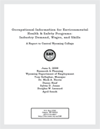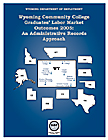Education
Wage Records Research

A new publication from the Research & Planning (R&P) section of the Wyoming Department of Workforce Services demonstrates R&P's ability to track Wyoming high school seniors into post-secondary education and the labor market.
The senior cohort for the academic year 2006/07 was used as an example throughout the publication. Key findings showed that 10 years after their senior year:
- 78.7% had attended either college or a university
- 39.8% earned a post-secondary award (certificate or degree)
- 49.2% were found working in Wyoming
Published September 29, 2021.
Outcomes
Post-Secondary Education Employment Outcomes
Click here for Wyoming post-secondary (colleges & university) employment outcomes.
Published November 2020.
Students Using LMI
Can High School Students Use Labor Market Information to Make Informed Career Choices?
High school students from Star Lane Center in the Natrona County School District (NCSD) were shown how to access occupational projections, wages, and other data provided by the Research & Planning (R&P) section of the Wyoming Department of Workforce Services. The students were tasked with analyzing their chosen career paths and presenting their findings to the Wyoming Workforce Development Council (WWDC).
The project required students to use occupational projections and wage information to analyze their chosen career paths in terms of the education required for the career and the potential for earnings once employed. Students were also asked to assess some of the vocational training opportunities proposed by NCSD’s forthcoming Center for Advanced and Professional Studies program. Students were given access to occupational wages, projections, and other R&P data in order to complete the project. Occupational wages and projections information used by the students can be found at http://doe.state.wy.us/LMI/projections.htm.
Presentation created by Star Lane students Katalin Gonzales, Alex Glover, Melissa Shoemaker, Logan Fox, Isaac Lee, Kellie Reynolds, Adam Couldridge, and Elias Vlastos.

Published June 2013.
- Educational Attainment in the United States: A Brief History
- Rising Enrollments and the Labor Market
- Function of a Four-Year Degree Today: How Meaningful is the Signifier?
- College Tuition vs. Future Earnings for Graduates
- Community Colleges and Credentialing: Closing the Skills Gap?
- Globalization and Higher Education
Wage Records Research

A Decade Later: Tracking Wyoming's Youth into the Labor Force
This article provides the context and explores issues related to exporting Wyoming’s youth and lays a foundation to better understand forthcoming research on the Hathaway Scholarship program (see related box on page 4), which provides tuition assistance to Wyoming’s youth who attend the state’s colleges and university.
The current research describes characteristics of a cohort (group) of 18-year-olds employed in Wyoming in 2000 in relation to Wyoming’s labor force across time.
Published March 2012.

Environmental Health & Safety Programs
Published June 5, 2008.

College Outcomes
Wyoming’s seven community colleges are one part of the state’s workforce development system. Graduates of these schools provide essential labor to the state’s economy in industries such as Health Care, Mining, and Education. This report presents a snapshot of that system by examining graduates’ employment and enrollment outcomes one year after graduation using administrative records exclusively. The report and tabulations were developed in response to a Memorandum of Understanding (MOU) with the Wyoming Community College Commission.
By coordinating survey research and administrative data, R&P has the ability to comprehensively describe and explain Wyoming labor market activities.
Our goal with this study is to describe student outcomes at a single point in
time. Many more questions remain about how the educational system functions
within the workforce development system.
Other Education Resources
Higher Education
Colleges and University






 Hire Wyo
Hire Wyo